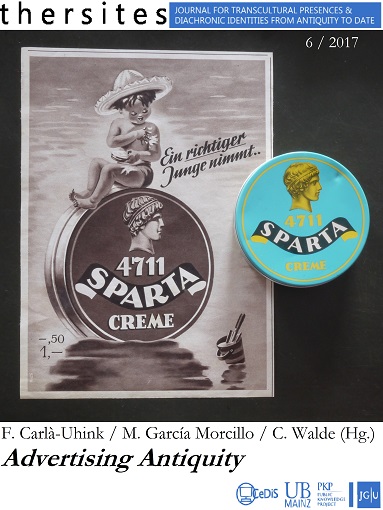Vote for Hermes – Grabstelen als Werbetafeln
DOI:
https://doi.org/10.34679/thersites.vol6.56Keywords:
Hermes, Grabstelen, Mysien, Bithynien, Hellenismus, Wahlwerbung, Polis, Identität, Bürgerideal, GymnasionAbstract
This paper presents a new approach to the study of Hellenistic grave stelai by comparing them to modern day, non-commercial billboard advertisements, such as election posters. The syncrisis shows that grave stelai not only had a private function for the remaining members of the family but also a “political” purpose as exemplification of the own social, economical and religious ideal. Both media show similarities by which the essay will be structured. They share characteristic settings hence they get only short attention. Furthermore they use similar iconographic strategies like the interaction of scripture and image, symbols and gesture. Taking the god Hermes as my central example, I argue that the grave stelai are a part of an intra-community discourse exemplary shown in rich seaports at the borders of the Greek world. In accordance with stelai election posters were made by a party to reach a group whose members identify themselves with the ideas of the party. Thus representations of Hermes were used to show the ideals of education, athletic competition, exemplary holding of public office, wealth and spending money for the community as well as the correct way of performing cult rituals.
Der Beitrag bietet einen neuen Blick auf antike Grabstelen, indem diese mit modernen, nicht-kommerziellen Werbetafeln wie Wahlplakaten verglichen werden. Durch die Gegenüberstellung wird deutlich, dass die Grabstelen neben der privaten Funktion für die Hinterbliebenen auch eine „politische“ Funktion als Ausdruck des eigenen sozialen, ökonomischen und religiösen Lebensideals hatten. Entsprechend ist der Aufsatz anhand der Ähnlichkeiten beider Medien strukturiert. So sind die charakteristischen Aufstellungskontexte beider vergleichbar aus denen eine kurze Aufmerksamkeit resultiert. Zudem wird bei beiden auf gleiche ikonographische Strategien zurückgegriffen wie das Zusammenspiel von Schrift und Bild, Symbole und Gesten. Als zentrales Beispiel wurden Darstellungen des Gottes Hermes gewählt, weil hierdurch gezeigt werden kann, dass Grabstelen ein Teil des innergemeinschaftlichen Diskurses zum Beispiel in den reichen Hafenstädten an den Rändern der griechischen Einflusssphäre waren. Genau wie die Grabstelen werden auch Wahlwerbeplakate von einer Gemeinschaft, zumeist der Partei, entwickelt, um eine Gruppe von Wählern zu erreichen, die sich mit den Ideen der Partei identifiziert. Als Ergebnis lässt sich festhalten, dass Darstellungen des Hermes benutzt wurden, um die bürgerlichen Ideale der Ausbildung, des sportlichen Wettkampfes, der korrekten Amtsführung, des Reichtums und der Freigebigkeit im Sinne der Gemeinschaft sowie der regelmäßigen und korrekten Hinwendung an die Götter zu präsentieren.References
siehe Word-Datei
Downloads
Additional Files
- Abb. 1: Wahlplakat von „Die Partei“ für die Wahl des Bürgermeister der Stadt und des Landes Berlin 2016 (Deutsch)
- Abb. 2: Wahlplakat der Partei „Bündnis 90/Die Grünen“ zur Bundestagswahl 2017 (Deutsch)
- Abb. 3: Weihrelief für Hermes und Kybele, Miletupolis (Deutsch)
- Abb. 4: Votivstele für Hermes Meletenos, Miletupolis (Deutsch)
- Abb. 5: Stele des Menis, Kyzikos (Deutsch)
- Abb. 6: Stele des Nikomachos, Nikomedeia (Deutsch)
- Abb. 7: Grabstele des Mokasios, Nikomedeia (Deutsch)
- Abb. 8: Grabstele eines Mannes, Kyzikos (Deutsch)
- Abb. 9: Grabstele aus Apollonia (Deutsch)
- Abb. 10: Dexiosisrelief aus dem Hierothesion in Kommagene (Deutsch)
- Abb. 11: Fragmentierte Stele, Nikomedeia (Deutsch)
- Abb. 12: Grabstele eines Knaben, Kyzikos (Deutsch)
- Abb. 13: Grabstele des Posides, Miletupolis (Deutsch)
Published
Issue
Section
License
Copyright (c) 2018 Antje Kuhle

This work is licensed under a Creative Commons Attribution-NonCommercial 4.0 International License.
Authors who publish with thersites agree to the following terms:
- Publishing in thersites is free of any charges.
- Authors retain copyright and grant the journal right of first publication.
- Users are allowed to read, download, copy, distribute, print, search, or link to the full texts of the articles, or use them for any other lawful purpose, without asking prior permission from the publisher or the author, so long as the original work is properly cited and is not used for commercial purposes. The journal is published under the Creative Commons Attribution 4.0 International License. More information about this license is available at https://creativecommons.org/licenses/by/4.0/.
- Authors are able to enter into separate, additional contractual arrangements for the non-exclusive distribution of the journal's published version of the work (e.g., post it to an institutional repository or publish it in a book), with an acknowledgement of its initial publication in this journal.
- Authors are permitted and encouraged to post their work online (e.g., in institutional repositories or on their website) as it can lead to productive exchanges, as well as earlier and greater citation of published work (See The Effect of Open Access).


